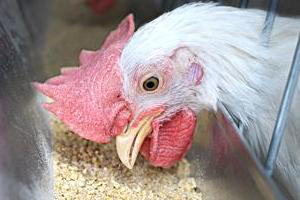Effect of antimicrobial peptide on broiler performance

ABSTRACT: A South Korean study investigated the effects of dietary supplementation of antimicrobial peptide-P5 (AMP-P5) on growth performance, nutrient retention, excreta and intestinal digesta microflora and intestinal morphology of broilers.
Three hundred twenty-d-old chicks (Ross 308) were randomly allotted to 4 dietary treatments, each consisting of 4 pens as replicates, with 20 chicks in each pen. The dietary treatments were: NC (negative control; basal diet), PC (positive control; basal diet supplemented with 15 mg avilamycin/kg diet) and AMP-P5 (basal diet supplemented with 40 and 60 mg AMP-P5/kg diets).
The experimental diets were fed in 2 phases, starter (d 0–21) and finisher (d 22–35). The overall (d 0–35) body weight (BW) gain and retention of dry matter (DM) and nitrogen (N; d 20–21 and d 34–35) were greater (P<0.05) in birds fed the PC and 60 mg AMP-P5/kg diets than birds fed the NC diet. Moreover, increasing levels of dietary AMP-P5 linearly (P<0.05) improved BW gain (starter, finisher and overall), feed conversion ratio (FCR; starter) and retention of DM and N (d 20–21 and d 34–35).
The population of excreta of total anaerobic bacteria (TAB, d 35) and coliforms (d 21 and d 35) and the ileal and cecal digesta coliforms (d 35) was fewer (P<0.05) in birds fed the PC and 60 mg AMP-P5/kg diets compared with birds fed the NC diet. The villus height of the duodenum and jejunum and villus height:crypt depth (VH:CD) of the duodenum, jejunum and ileum were greater (P<0.05) in the birds fed the PC and 60 mg AMP-P5/kg diets than birds fed the NC diet. Increasing levels of dietary AMP-P5 linearly (P<0.05) reduced (P<0.05) excreta TAB (d 35), coliforms (d 21 and d 35) and the coliforms in the ileal and cecal digesta (d 35). Moreover, increasing levels of dietary AMP-P5 linearly increased (P<0.05) villus height (duodenum and jejunum) and VH:CD (duodenum, jejunum and ileum) and linear reduction (P<0.05) in crypt depth of the jejunum.
These results indicate that dietary supplementation with 60 mg AMP-P5/kg has the potential to improve the growth performance, nutrient retention, intestinal morphology and reduce intestinal and excreta coliforms in broilers.
Source: Animal Feed Science and Technology













